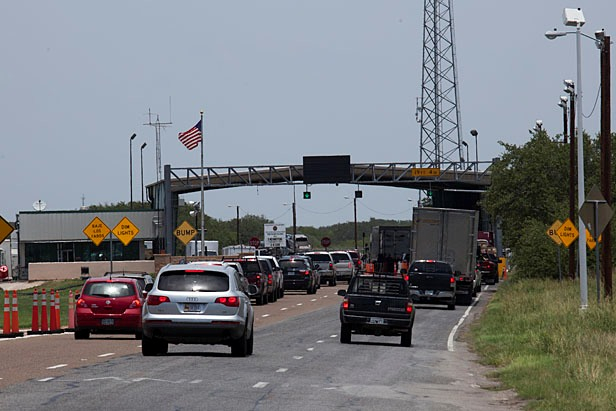Life and Death on the 'Second Border'

The punishing terrain of south Texas swallows many migrants, who must cross a "second border" after the Rio Grande, hiking 20 miles through scorching desert to get around this Border Patrol checkpoint on Highway 281 south of Falfurrias, Texas. Photo: Jim West/jimwestphoto.com.
She stepped out of the Border Patrol truck sobbing.
From San Luis Potosi in north central Mexico, the 39-year-old woman had successfully slipped across the Rio Grande and had been trying to walk around a permanent Border Patrol checkpoint on Highway 281 near Falfurrias, Texas. It’s what some call the “second border,” 70 miles north of the river.
I didn't ask her name. I don’t know if she was entering the U.S. to find work. I don’t know if she had children. I don’t know what her hopes and dreams were.
All I know is that they ended on July 24 in the inhospitable terrain of the world-famous King Ranch. A few feet away, her husband lay dead in the sand.
Brooks County Chief Deputy Sheriff Benny Martinez had arranged for me to ride along with one of his officers to see what the terrain looks like that swallows so many migrants.
Scorching Heat
Relatively few die trying to cross the Rio Grande. The second border is the real killer. The coyote will drop them off around Encino, south of the checkpoint, with instructions to walk to Highway 285, maybe 20 miles away.
Sometimes the migrants will be told it's a 30 minute walk. But even if they know the highway is a couple days away, few are prepared for the conditions. The temperature in Falfurrias today (July 24) was 100 degrees. Tomorrow 99. Friday 99. Saturday 100 again.

SUPPORT LABOR NOTES
BECOME A MONTHLY DONOR
Give $10 a month or more and get our "Fight the Boss, Build the Union" T-shirt.
Think about trying to walk 20 miles along the beach—not in the hard-packed sand by the shore, but in dry sand dunes in which every step is an effort. That's what the ground is like at the King Ranch. The scrub brush is thick enough that it’s easy to get lost, and heavy enough to block any breeze. The sun beats down all day.
The couple was found because the wife called 911. Her husband had lain down to rest, and then stopped breathing. By the time the Border Patrol arrived, he was gone.
When we got there, he lay under a tree, one hand outstretched, the other on his belly. A sheet covered his face.
Almost Every Day
There were about a dozen Border Patrol officers, a deputy sheriff, a Justice of the Peace, three funeral home employees, and a man wearing a bullet-proof vest. The latter was a moonlighting policeman whose charge was to prevent bad publicity for his employer, the King Ranch.
When I got out of the deputy's truck, I spent a few minutes thinking about how I could photograph the scene while being respectful of the dead man. As I considered, the bullet-proof vest pointed at me. Invoking “private property,” he said there could be no pictures of anything, even of the deputy writing his report, or of the sand and trees of the ranch.
Before she was led away, the new widow was given a chance to say good-bye. Tears running down her face, she walked back to her husband's body, laying her hand on his chest. As she was driven off by a Border Patrol agent, the funeral home workers wrestled the corpse into a body bag. They had a difficult time carrying it away through the deep sand.
I asked the Justice of the Peace how often his happens. “In the summer?” he asked. “Almost every day.”



